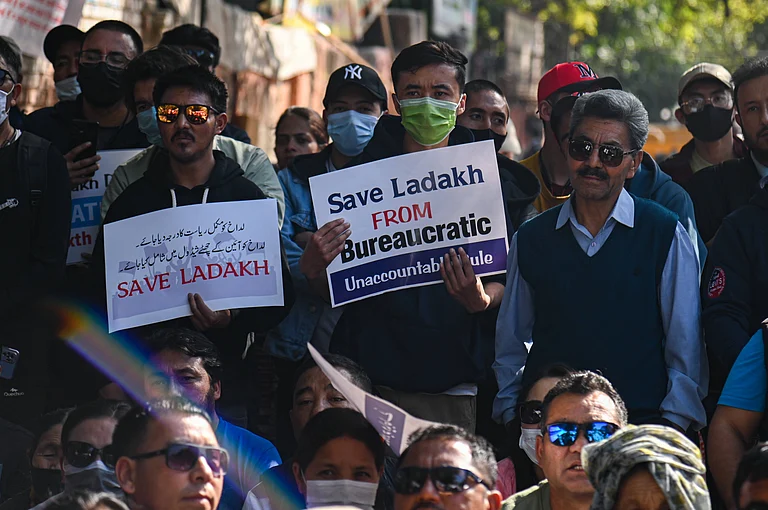On February 3, the Polo Ground in Leh emerged as the heart of Ladakh’s long struggle to preserve its tribal identity. From the farthest reaches of the icy desert, Ladakhis assembled on the vast ground to lend their voices to the cause. In a sea of banners declaring “Ladakh Demands Sixth Schedule” and “Ladakh Demands Statehood”, the protests drew focus on the region, which often remains in the news for the India-China conflict along the Line of Actual Control (LAC).
Just on January 30, a group of shepherds in the remote Nyoma village in eastern Ladakh stood firm against Chinese soldiers who were trying to prevent them from grazing their sheep near the LAC. This confrontation indicates the growing impatience of Ladakhis who have been denied access to grazing land since the 2020 Galwan Valley clash. Despite facing at least three Chinese armoured vehicles and several soldiers, the shepherds’ defiance earned them widespread acclaim across India.
Inside the region, Ladakhi leaders have deep-seated fears of marginalisation by powerful corporate interests and a possible influx of the mainland population. With the loss of the protective cover of Article 370, which safeguarded its land and people, Ladakh now faces an uncertain future, overshadowed by concerns of exploitation and demographic shifts.
In these protests dotting the region for the past few years, a prominent figure, Sonam Wangchuk—known nationwide for his innovative spirit and for being the inspiration behind the film, 3 Idiots—has come to the forefront.
Wangchuk’s address was a mix of hope, frustration and warning. He reminded the BJP of its commitment to grant the Sixth Schedule status to Ladakh and urged the party to fulfil it promptly. He invoked the legacies of figures like Sukhdev and Bhagat Singh, drawing parallels to their steadfast determination and sacrifice. He went on to say if Ladakhis have to sacrifice their lives for the truth, they would.
Ladakhi leaders know their options are limited, but They hope that in the upcoming meeting between Ladakh’s leaders and the Union home ministry, a solution will emerge.
Like last year at Jantar Mantar, Wangchuk at the Polo Ground integrated the climate crisis into his arguments, saying that Ladakh shouldn’t face the same fate as other Himalayan states. He has been saying that Ladakhi protests are not against outsiders, but to save the culture of Ladakh and the environment from all, including Ladakhis.
The protest call was given by the Leh Apex Body (LAB) and the Kargil Democratic Alliance (KDA) to press the government to accept their demands, including statehood for Ladakh, constitutional safeguards under the Sixth Schedule of the Constitution of India to protect the interests of the tribal people of Ladakh, formation of a Public Service Commission, job reservation for the youth of Ladakh and the creation of two separate parliamentary constituencies for Leh and Kargil.
On January 26 last year, Wangchuk held a climate fast at the Himalayan Institute of Alternatives in Ladakh, which was reeling under minus 20-degree Celsius temperatures. He was planning to hold the fast at 18,000 feet at Khardung La Pass where the temperature dips to minus 40 degrees C, but fearing for his health, the government didn’t allow him to move towards Khardung La.
Ahead of his fast last year, the Ramon Magsaysay Award winner called on the government saying that Ladakh’s fragile environment and its people deserve the Sixth Schedule status under the Indian Constitution.
Wangchuk has argued that no Ladakhi has ever advocated separation from the Indian Union. He has highlighted the Ladakhis’ unwavering support for India and its armed forces. But he has also asked what stops the government from providing the necessary constitutional safeguards under the Sixth Schedule.
The protesters seem to have realised that Parliament is in session and the focus on Ladakh might compel the government to take up the issue. The Sixth Schedule can be extended to any region only if Parliament gives consent.
The Sixth Schedule of the Constitution provides for the special administration of tribal areas in Assam, Meghalaya, Tripura and Mizoram to safeguard the rights of the tribal population in these states. This special provision is provided under Article 244(2) and Article 275(1) of the Constitution. Passed by the Constituent Assembly in 1949, the Sixth Schedule was formulated to provide limited autonomy to the tribal regions of the Northeast. It allows tribals to exercise legislative and executive powers through an autonomous regional council and autonomous district councils (ADCs).
“The Ladakh and Jammu regions for long resented being in the shadow of the Kashmir valley and complained that they were discriminated against by the Valley-based state governments. New Delhi also encouraged the anti-Kashmiri sentiment in Ladakh and Jammu regions propagating a divide and rule policy. Ladakh has a long history of demanding for a separate Union Territory status, and they celebrated the scrapping of Article 370. But after the reorganisation of the erstwhile Jammu & Kashmir (J&K) state into two Union Territories, though the central government has consistently assured J&K of restoring statehood at an opportune time, no such promise was made to Ladakh,” says Praveen Donthi, a senior analyst with Crises Group India.
With the safeguards under Article 370 gone, the people of Ladakh soon realised that the territory, its land, culture and fragile environment are at a greater risk due to the possible influx of outsiders, argues Donthi. “After studying the status of other Sixth Schedule states, they had started demanding Sixth Schedule status and statehood. The government, however, looks reluctant to grant such a status. New Delhi probably didn’t anticipate China’s adverse reaction to the reorganisation of J&K, which includes Ladakh. With the China threat looming large on the border now, it would like to have direct control, hence the Union Territory status,” he says.
“One of the reasons why the government didn’t go for a trifurcation of J&K in 2019 is probably because it didn’t want to concede space and voice to Kashmir’s political aspirations. The same could be true of Ladakh as well, as it shares religious and cultural heritage across the border with Tibet,” says Donthi. “A nation state is always weakest in its peripheries hence they would like to exercise more control over those territories,” says Donthi.
MORE FROM THIS ISSUE
Wangchuk hopes that in the upcoming meeting between Ladakh’s leaders and the Union home ministry on February 19, a solution will emerge. Ladakhi leaders know their options are limited, but they are not in a mood to give up. Wangchuk says the LAB president, Thupstan Chhewang, has declared that he will go on a prolonged fast after February 19 if nothing emerges out of the meeting. “Ladakh will burn if anything happens to Thupstan Chhewang,” he says. Ladakhi leaders are ready for a showdown and all eyes are now on the Union government.
Naseer Ganai in Srinagar
(This appeared in the print as 'As Old As The Hills')
































